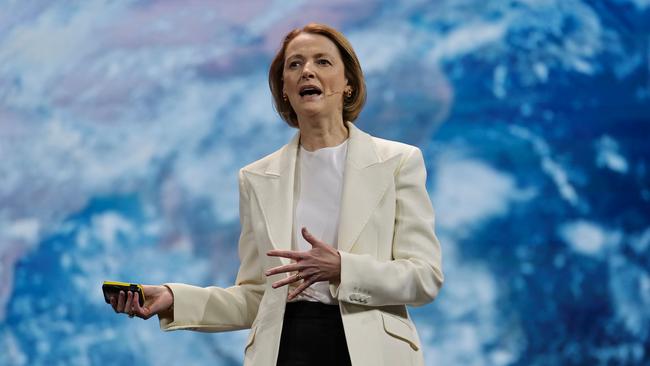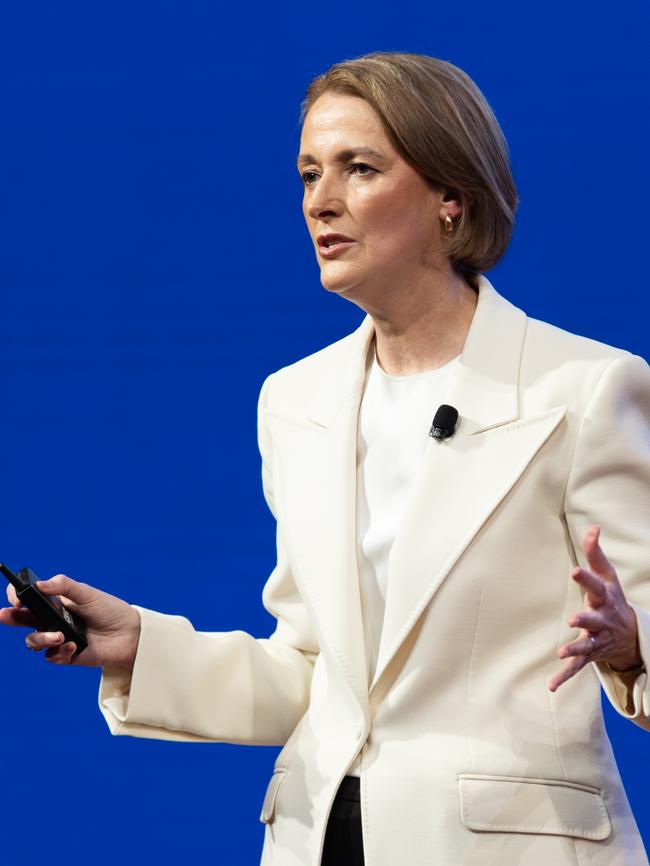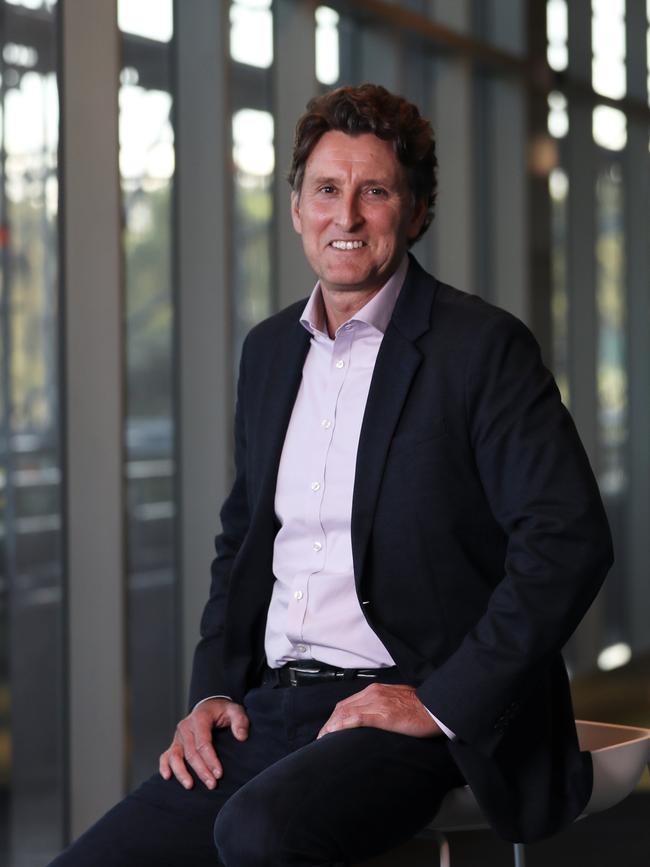Telstra chief Vicki Brady reveals new strategy for investors
The nation’s biggest telco has told investors artificial intelligence and digital infrastructure are key focuses for the next five years, with the business at an ‘inflection point’.

Telstra chief executive Vicki Brady has unveiled a bold five-year strategy to catapult the lumbering telco to the vanguard of the artificial intelligence boom, including harnessing the much-hyped technology to not only detect but “heal” faults in its network.
Ms Brady presented her strategy to investors on Tuesday which aims to set Telstra up until the end of the decade and ensure it’s fit to deliver 6G as Australians use more data than ever.
She also defended accusations from rival and Vodafone owner TPG that Telstra had “grossly” overstated the size of its network.
In a week of flip-flopping, Telstra said its coverage claim was based on an expensive external antenna, and then said such equipment was not necessary.
“We have 3 million square kilometres of coverage and it doesn’t require an antenna,” Ms Brady said when asked on Tuesday.
“Through the 3G closure and expansion of 4G networks there has been a huge amount of work ... when we got challenged on that recently we took the time to understand it and recheck, we ran additional testing and yes, we stand by the three million square kilometres of coverage without an antenna.
“There’s no doubt we have the best, we have the largest mobile network in the country and we can see that through (how many customers we have).”
The competition regulator is assessing the allegations from TPG, which accused Telstra of having misstated its network size by about one million square kilometres, or the landmass of NSW, Victoria and ACT combined.

Telstra’s Connected Future 30 strategy is a three-pronged plan to grow its strategic net promoter score — a customer loyalty metric — to more than 50 per cent; to deliver ‘network as a product’ by lifting network experience and deriving the majority of its connectivity revenue from this segment; and, to grow its digital infrastructure business to sustained earnings before interest and tax growth, with all three targets to be met by 2030.
Telstra’s ‘network as a product’ aims “to reinvent how we create and capture value” by improving uplink speeds and latency, with $800m of capital expenditure recently invested in the mobile network to help Telstra compete.
“For customers, it means we’re going to raise the bar on reliability and consistency,” said Ms Brady.
“We will reinvent how we create and capture value from our network. This means thinking differently about how we ‘productise’ and price it, so we get the value we need as we build more capacity and deliver more sophisticated connectivity.
“This includes how we monetise network features our customers value, like uplink speeds, latency and enhanced security … and enabling access to capabilities to create new products or experiences,” like a scam indicator with Commonwealth Bank.
As part of the ‘network as a product’ bet, the Telstra Autonomous Network will leverage AI and cloud technology to “simplify the network interaction with self-configuring, self-optimising and self healing properties” Telstra claimed.
Ms Brady stressed a key mission of the five-year plan was improving Telstra’s financial discipline, targeting positive operating leverage and “stepping up our focus on efficiency across everything we do and consistently pulling levers, like the use of AI”.
Will Telstra use AI to cut jobs?
Ms Brady said artificial intelligence “will be a significant unlock” for the workforce, but at the expense of staff. Without providing exact numbers, Ms Brady acknowledged the telco’s workforce in 2030 will be smaller than it is today.
What is growing, however, is Telstra’s investment in digital infrastructure such as data centres as mobile data needs grow exponentially.
“We are in the early stages of a super cycle of investment in digital infrastructure,” said Ms Brady. “Being driven by unrelenting demand for more data and connectivity. In five years, we’ve seen data on our mobile network more than triple. There’s no version of the future that doesn’t rely on technology, and it all needs to be connected.
“Over the next five years, as new technologies including AI continue to be adopted, we expect the pace and scale of change to be extraordinary, driving even more demand for secure and reliable connectivity.
“And who we’re competing with is changing. Whether it’s hyperscalers or device vendors, many players see the opportunity, and it’s on us to move fast.”

Goldman Sachs analysts led by Kane Hannan were surprised at the lack of explicit investment in digital infrastructure: “We had thought greater digital infrastructure investment could be announced,” the analysts said.
Her comments come on the heels of Telstra’s infrastructure arm, Telstra InfraCo, poaching Microsoft Australia and New Zealand boss Steven Worrall to head its data centre and tower-focused business.
Earlier on Tuesday Telstra reaffirmed full-year guidance of underlying EBITDA between $8.5bn and $8.7bn, business as usual capex of between $3.2bn and $3.4bn, and free cashflow after lease payments of between $3bn and $3.4bn.
Telstra shares rose 2c to $4.75.






To join the conversation, please log in. Don't have an account? Register
Join the conversation, you are commenting as Logout